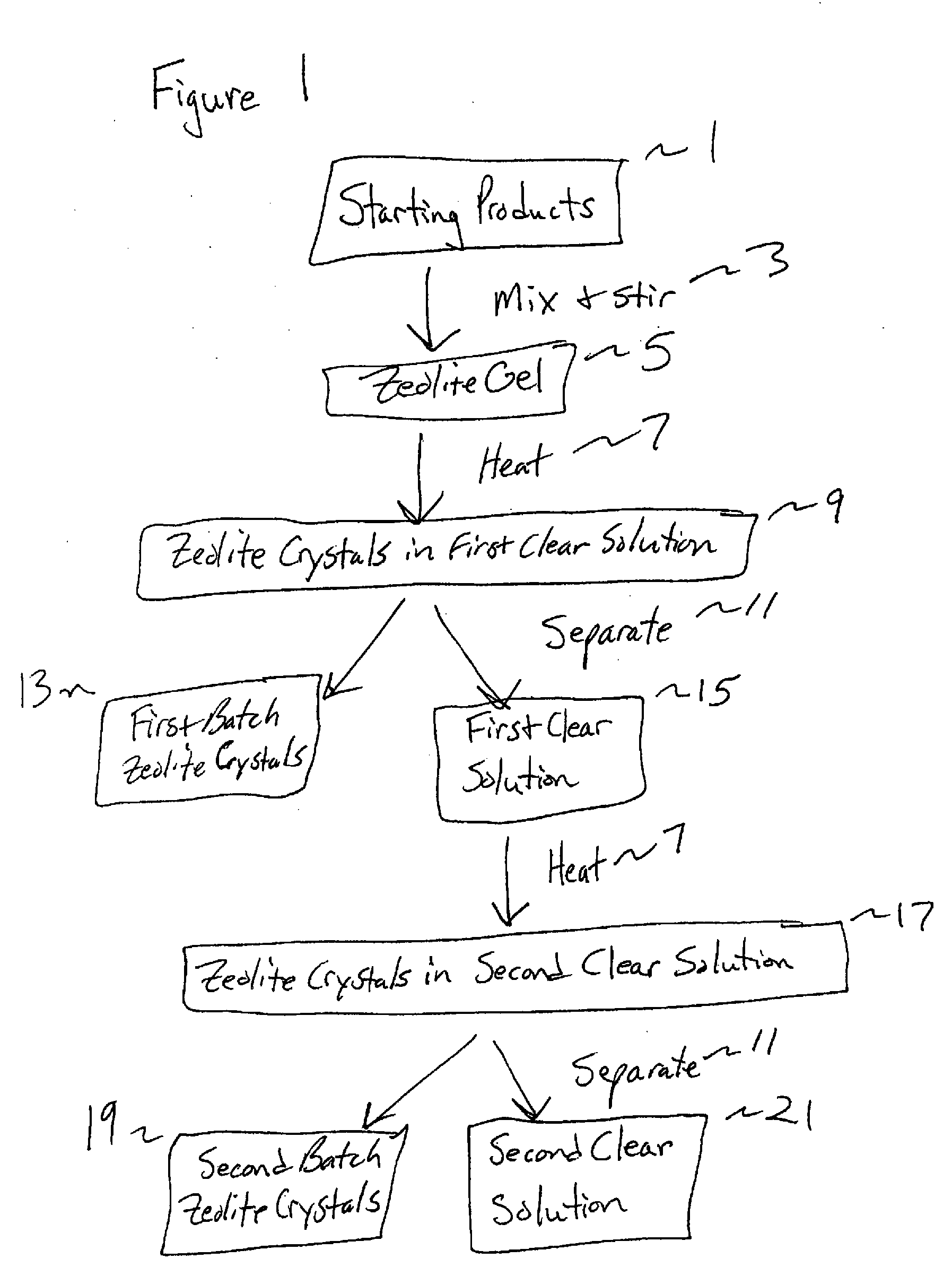Synthesis and use of nanocrystalline zeolites
a technology of nanocrystalline zeolites and zeolites, which is applied in the direction of nitrous oxides, physical/chemical process catalysts, silicon compounds, etc., can solve the problems of long synthesis time, adverse environmental effects, low product yield, etc., and achieves the elimination of long nucleation and growth times, high yield, and high yield
- Summary
- Abstract
- Description
- Claims
- Application Information
AI Technical Summary
Benefits of technology
Problems solved by technology
Method used
Image
Examples
example 1
[0059]FIGS. 3 and 4 depict the X-ray diffraction (XRD) powder patterns of silicalite-1 and Y zeolites, respectively, obtained from multiple rounds of zeolite synthesis in which the clear solution recovered after removal of zeolite nanocrystals was reused. The patterns (a)-(e) shown in FIG. 3 correspond to consecutive batches (1-5) of silicalite-1 zeolites. The patterns (a)-(d) shown in FIG. 4 correspond to the first, fourth, seventh and tenth batch of Y zeolites. Each XRD pattern is consistent with the silicalite-1 or Y zeolite structure, respectively. The intensities and line widths of the XRD peaks are similar to each other for each zeolite, suggesting that the different batches of the same zeolite have similar crystal sizes.
[0060] The BET surface areas (of as-synthesized samples) and the Si / Al ratios (for Y zeolites) were measured and are listed in FIG. 5 along with the cumulative nanocrystalline zeolite yields for each batch. The zeolite yield was calculated from the initial sy...
example 2
Zeolite Sample Preparation and Materials
[0068] Nanocrystalline NaY zeolite was synthesized using clear solutions as discussed above. Sodium hydroxide (NaOH), aluminum isopropoxide, tetramethylammonium hydroxide (TMAOH) and distilled water were mixed and stirred until the resulting mixture became a clear solution. Then tetraethyl orthosilicate (TEOS) was added to the clear solution. The clear solution mixture was stirred overnight to ensure complete hydrolysis of the aluminum and silicon sources. The final clear synthesis gel had the following composition: 0.07Na:2.4TMAOH:1.0Al:2.0Si:132H2O:3.0i-PrOH:8.0EtOH (mol ratio), the latter two alcohols came about from the hydrolysis of the aluminum isopropoxide and TEOS, respectively. In order to optimize the formation of small NaY crystals, the sodium content was intentionally set too low relative to aluminum content in the synthesis gel. The clear solution was transferred into a 500 ml flask equipped with an air cooled condenser and was ...
example 3
Solid State MAS NMR Experiments
[0073] Approximately 0.2 g of zeolite was impregnated with an aqueous solution of labeled urea (13C and 15N). Samples with adsorbed urea were allowed to dry at room temperature and were placed into pyrex sample tubes that were degassed on a vacuum rack. To prepare samples containing labeled urea and nitric oxide and oxygen, the nitric oxide and oxygen were introduced to the zeolite sample while still attached to the vacuum rack. Then, the pyrex sample tube was sealed while the sample was immersed in liquid nitrogen. The sealed samples were heated for 1 hour at the desired temperatures. Samples were allowed to cool to room temperature for the NMR measurements.
[0074] Magic angle spinning (MAS) NMR spectra were obtained using a 7 Tesla wide bore Bruker cryomagnet and a TecMag Discovery console. The Larmour frequencies for 13C and 15N were 75.470 MHz and 30.425 MHz, respectively. A Chemagnetics double-channel 7.5 mm pencil MAS probe was used to spin rot...
PUM
| Property | Measurement | Unit |
|---|---|---|
| Volume | aaaaa | aaaaa |
| Fraction | aaaaa | aaaaa |
| Fraction | aaaaa | aaaaa |
Abstract
Description
Claims
Application Information
 Login to View More
Login to View More - R&D
- Intellectual Property
- Life Sciences
- Materials
- Tech Scout
- Unparalleled Data Quality
- Higher Quality Content
- 60% Fewer Hallucinations
Browse by: Latest US Patents, China's latest patents, Technical Efficacy Thesaurus, Application Domain, Technology Topic, Popular Technical Reports.
© 2025 PatSnap. All rights reserved.Legal|Privacy policy|Modern Slavery Act Transparency Statement|Sitemap|About US| Contact US: help@patsnap.com



